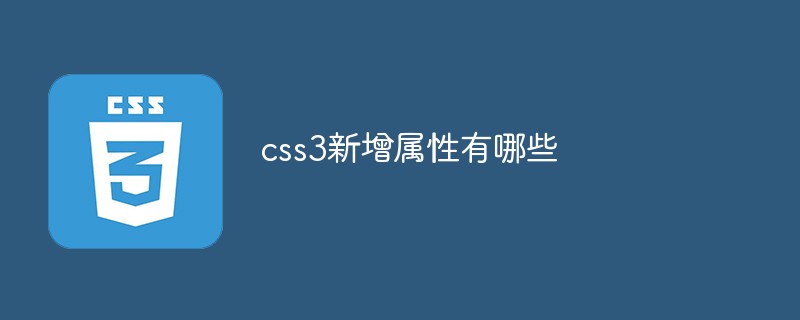
The new properties of css3 include: word-wrap, word-break, text-shadow, border-radius, box-shadow, border-image, background-size, transform, transition, etc.

The operating environment of this tutorial: Windows 7 system, CSS3 version, Dell G3 computer.
css3 new attributes
1. CSS3 text effect:
hanging-punctuation: Specifies whether punctuation characters are located outside the wireframe.
punctuation-trim: Specifies whether to trim punctuation characters.
text-align-last: Sets how to align the last line or the line immediately before a forced newline.
text-emphasis: Applies an emphasis mark and the emphasis mark's foreground color to the element's text.
text-justify: Specifies the alignment method used when text-align is set to "justify".
text-outline: Specifies the outline of the text.
text-overflow: Specifies what happens when text overflows the containing element.
text-shadow: Adds a shadow to text.
text-wrap: Specifies the line wrapping rules for text.
word-break: Specifies the line breaking rules for non-Chinese, Japanese and Korean text.
word-wrap: Allows long indivisible words to be split and wrapped to the next line.
2. CSS3 border:
border-radius: CSS3 rounded border.
box-shadow: Used to add a shadow to the box.
border-image: CSS3 border image, you can use images to create borders.
3. CSS3 background:
background-size: The attribute specifies the size of the background image.
background-origin: The attribute specifies the positioning area of the background image.
background-clip: Specifies the drawing area of the background.
(Learning video sharing: css video tutorial)
4. CSS3 conversion:
transform Applies a 2D or 3D transformation to an element.
transform-origin allows you to change the position of the element being transformed.
transform-style specifies how nested elements are displayed in 3D space.
perspective Specifies the perspective effect of 3D elements.
perspective-origin specifies the bottom position of the 3D element.
backface-visibility Defines whether the element is visible when not facing the screen.
5. CSS3 transition:
Add effects to elements when they transform from one style to another.
transition: shorthand attribute, used to set four transition attributes in one attribute.
transition-property: Specifies the name of the CSS property that applies the transition.
transition-duration: Defines how long the transition effect takes. The default is 0.
transition-timing-function: Specifies the time curve of the transition effect. The default is "ease".
transition-delay: Specifies when the transition effect starts. The default is 0.
6. CSS3 animation: Through CSS3, we can create animations, which can replace animated images, Flash animations and JavaScript in many web pages.
@keyframes: Specifies animation.
animation: Shorthand property for all animation properties, except animation-play-state property.
animation-name: Specifies the name of the @keyframes animation.
animation-duration: Specifies the seconds or milliseconds it takes for the animation to complete one cycle. The default is 0.
animation-timing-function: Specifies the speed curve of animation. The default is "ease".
animation-delay: Specifies when the animation starts. The default is 0.
animation-iteration-count: Specifies the number of times the animation is played. The default is 1.
animation-direction: Specifies whether the animation plays in reverse in the next cycle. The default is "normal".
animation-play-state: Specifies whether the animation is running or paused. The default is "running".
animation-fill-mode: Specifies the state outside the object animation time.
7. CSS3 multiple columns:
column-count: Specifies the number of columns by which elements should be split.
column-fill: Specify how to fill the column
column-gap: Specify the gap between columns
column-rule: Abbreviation for all column-rule-* attributes
column-rule-color: Specifies the color of the border between two columns
column-rule-style: Specify the style of the border between two columns
column-rule-width: Specify the thickness of the border between two columns
column-span: Specify how many columns the element spans
column-width: Specify the width of the column
columns: abbreviation for setting column-width and column-count
8. CSS3 user interface:
resize: The attribute specifies whether the element can be resized by the user.
box-sizing: Property allows you to define in an exact way how specific content will be adapted to a certain area.
outline-offset: Property offsets the outline and draws the outline beyond the edge of the border.
appearance: Allows you to make an element look like a standard user interface element.
icon: Provides creators with the ability to set elements to their icon equivalents.
nav-down: Specifies where to navigate when using the arrow down navigation key.
nav-index: Specifies the order of the Tabs of an element.
nav-left: Specifies where to navigate using the left arrow navigation keys.
nav-right: Specifies where to navigate using the right arrow navigation keys.
nav-up: Specifies where to navigate when using the Arrow Up navigation key.
For more programming-related knowledge, please visit: Programming Video! !
The above is the detailed content of What are the new attributes in css3. For more information, please follow other related articles on the PHP Chinese website!